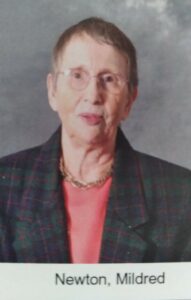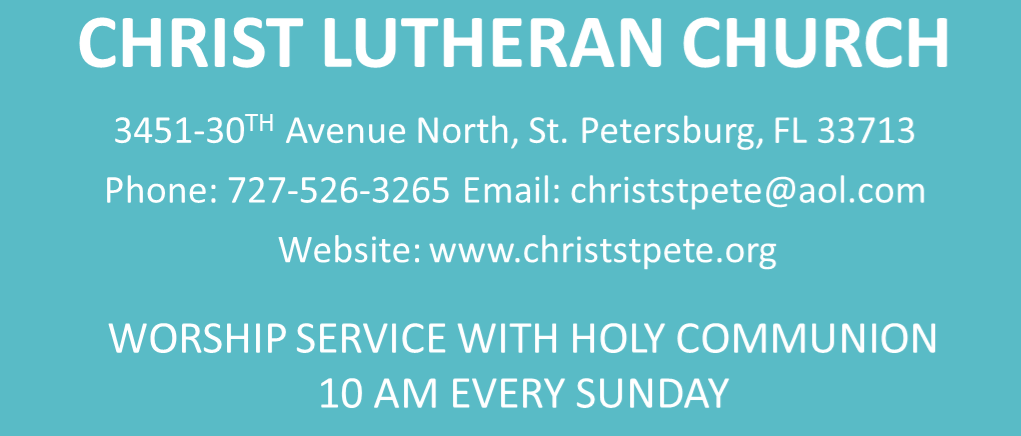Our Christian Vocabulary
By Mildred Newton, updated 2023 by Sharon Centanne, webmaster

AGNUS DEI – Latin words for “Lamb of God”. Jesus Christ, our Lord was sacrificed for our sins, an Innocent for the Guilty, and is symbolized as a sacrificial lamb used as used in worship services before the Death of Christ of on Cross.
AUREOLE – An oval shape around the head or body of Jesus Christ, and sometimes Mary and the Saints.
BAPTISMAL FONT – Receptacle with a container to
hold the waters of baptism. Christ Lutheran Church
baptizes those of all ages, including babies using
the pouring water on the forehead method, baptizing
always “In the Name of the Father and of the Son and
of the Holy Spirit” as commanded in the Great Commission recorded in the Gospel of Matthew 28:19-20.
BUTTRESS – an extra column on the outside of a wall to support the wall, especially if the wall is tall. Some buttresses include an arch underneath them and are called flying buttresses. Notre Dame Cathedral in Paris, France has many flying buttresses. The arches in front of Christ Lutheran Church resemble flying buttresses but are actually an arch supporting the front of the roof.
CHALICE – the cup, usually stemware, used for the Communion Wine when the pastor speaks Christ’s words “This is My Blood”.
CHANCEL – Area of a church sanctuary, usually a raised “stage” in front of the congregation, where the Altar, Pulpit and Lectern appropriate chairs, and in some churches, the choir are located. The Chancel area is sometimes but not always surrounded by the Communion aisle and will be decorated with various seasonal paraments, candles, flowers, and other items needed for worship.
CHURCH – The people who believe in Jesus Christ and the Holy Trinity. Sometimes the worship building of gathered Christians is known as a church, short for church building or sanctuary.
CRISMON – Christian Christmas ornaments with Christian symbolism. Chrismons are a modern tradition involving the use of white Christmas ornaments each symbolizing some aspect of Christianity.
CLERESTORY – At Christ Lutheran, the Clesestory Windows are located in the old sanctuary
now Luther Hall. The are windows located at the top
of the sanctuary, and many of ours still have stained glass with Christian symbols.
COMMUNION RAIL – A functional rail at the edge of the Chancel so people kneeling for communion have something on which to place their hands. It has no liturgical significance, and is not meant to keep people away from the altar, only to help them steady themselves. Some churches have done away with the Communion Rail, especially if they only practicewalk-through reception of Communion. The center of the rail is left open for easy access to the altar by the Pastor and other participants.
DIET OF WORMS – In the Sixteenth Century, important desicions were made at Diets, similar to our court hearings. Worms (“Verms” in German) is the name of the city in Germany where Martin Luther was questioned about his 95 Theses (religious statements).
ELEGY – usually a song or poem expressing the serious thoughts of the dead. One of our windows is a type of Ellegy, showing symbols used at funerals. Our sanctuary is used for funerals when necessary.
EPIPHANY – From the Greek words for “Made Manifest”.
January 6th is the festival date for when the Wise Men traditionally arrived in Bethlehem, and the date commemorating Jesus’ baptism. For several weeks thereafter, the Gospel readings commemorate Christ’s life and His showing himself to His people, and are known as the Epiphany Season in the Church. Pastors
wear Green Vestments and we use Green Paraments to represent the Season of Epiphany.
FELLOWSHIP HALL – gathering place for social events of the church, usually after the service and often used for fund raising or large meetings or parties. The Fellowship Hall at Christ Lutheran Church is named Luther Hall.
GOSPELLER – The first four books of the New Testament are known as the Gospels, or Good News. The author of one of the Four Gospels in the New Testament – Matthew, Mark, Luke and John are sometimes referred to as Gospellers, as they tell us the Good News of Salvation. Matthew, Mark and Luke have similar writing styles and these three Gospels are known as the Synoptic Gospels. One is focused on each year in a three year cycle. John’s writing style is more cyclic and his Gospels are used every year.
INCENSE – Smoke from spices or other materials burned in some churches during religious services, and symbolizing the prayers of the people rising to
God. Insense is usually burned and distributed from
an incenser, a container with holes for the incense
smoke to escape, and this container is often on a stick or a chain to help spread the smoke over the congregation.
LECTERN – Podium for reading the First and Second readings, prayers, and other non-Gospel messages, used by Lectors, Worship Assistants and others.
LECTIONARY – a schedule of scriptural readings for use throughout the church year. Christ Lutheran Church uses the same Lectionary as the Missouri Synod Lutheran churches. A lectionary assures that all churches are celebrating major feasts at the same time.
NARTHEX – The Vestibule or closed area just inside the doors to the church building, and to the rear of the Nave. The Narthex functions as a welcome center or lobby, and where people can gather before entering the church for a procession or funeral. The Narthex at Christ Lutheran is aslo where the Greeters stand, where we collect food for the Free Clinic, and where were have updated publications and handouts for distribution to all who attend. The word Narthex comes from the Greeks.
NAVE – the area of the church where the congregation sits, which resembles a ship, with rows of wooden seats known as pews.
PATEN – the plate holding the Communion Bread.
PEWS – wooden benches to allow flexible seating in the Nave.
PULPIT – podium where Pastor preaches
REFORMATION – The time period beginning with Luther’s nailing his 95 theses to the Church door at Whittenberg Cathedral on October 31, 1517, and celebrated to this day on the last Sunday of October. Reformation commemorates Luther’s discovery in original church scriptures that we are saved by “Grace Alone, Faith Alone, Scripture Alone”, a discovery which both divided and renewed the Church.
SACRISTY – room usually behind the altar where the items needed for worship are stored.
SANCTUARY – large room where we gather for worship. Seating faces chancel area and altar. Choir may be seated in Sanctuary or in Choir Loft.
VESTIBULE – name some churches give their Narthex. From the Latin meaning “to dress”. In colder climates, coats, wraps and boots are often removed here when entering the church. In Florida, it is mostly a welcome center and a place to line up for processions.
VESTMENTS – The colorful poncho style silk vest the Pastor wears which indicates which Season of the Church Year or which Feast Day we are celebrating. For more information about the Church Year and the colors used, please see our Church Year page, and the Our Paraments page.

